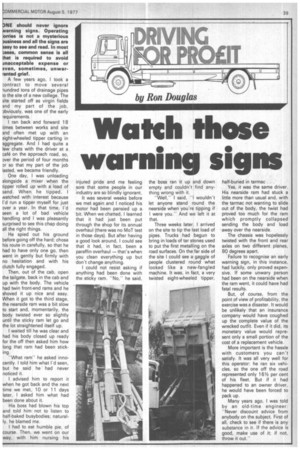Watch those warning signs
Page 41

If you've noticed an error in this article please click here to report it so we can fix it.
)NE should never ignore 'yarning signs. Operating orries is not a mysterious Jusiness and all the signs are easy to see and read. In most :eases, common sense is all that is required to avoid anacceptable expense or even, sometimes, unwarranted grief.
A few years ago, I took a contract to move several riundred tons of drainage pipes to the site of a new college. The site started off as virgin fields and my part of the job, Dbvio us I y, was one of the early requirements.
I ran back and forward 18 times between works and site and often met up with an eight-wheeled tipper carting in aggregate. And I had quite a Few chats with the driver at a café on the approach road, so, aver the period of four months Dr so that my part of the job lasted, we became friendly.
One day, I was unloading alongside a mixer when the tipper rolled up with a load of sand. When he tipped, I watched with interest because I'd run a tipper myself for just aver a year. In that time, I'd seen a lot of bad vehicle handling and I was pleasantly surprised to see this chap doing all the right things.
He spied out his ground before going off the hard; chose his route in carefully, so that he had to have only one go, then went in gently but firmly with no hesitation and with his clutch fully engaged.
Then, out of the cab, open the tailgate, back in the cab and up with the body. The vehicle had twin front-end rams and he shoved it up nice and easy. When it got to the third stage, the nearside ram was a bit slow to start and, momentarily, the body twisted ever so slightly until the sticky ram let go and the lot straightened itself up.
I waited till he was clear and had his body closed up ready for the off then asked him how long that ram had been sticking: "What ram" he asked innocently. I told him what I'd seen, but he said he had never noticed it.
I advised him to report it when he got back and the next time we met, 10 or 11 days later, I asked him what had been done about it.
His boss had blown his top and told him not to listen to half-baked busybodies; naturally, he blamed me.
I had to eat humble pie, of course. Then, we went on our way, with him nursing his injured pride and me feeling sore that some people in our industry are so blindly ignorant, It was several weeks before we met again and I noticed his motor had been pansied up a_ bit. When we chatted, I learned that it had just been put through the shop for its annual overhaul (there was no MoT test in those days). But after having a good look around, I could see that it had, in fact, been a paraffin overhaul — that's when you clean everything up but don't change anything.
I could not resist asking if anything had been done with the sticky ram. "No," he said, the boss ran it up and down empty and couldn't find anything wrong with it.
-Well," I said, "I wouldn't let anyone stand round the nearside when you're tipping if I were you.And we left it at that.
Three weeks later. I arrived on the site to tip the last load of pipes. Trucks had begun to bring in loads of tar stones used to put the first metalling on the road surfaces. On the far side of the site I could see a gaggle of people clustered round what looked like a new-fangled machine. It was, in fact, a very twisted eight-wheeled tipper, half-buried in tarmac . .
Yes, it was the same driver. His nearside ram had stuck a little more than usual and, with the tarmac not wanting to slide out of the body, the twist had proved too much for the ram which promptly collapsed sending the body and load away over the nearside.
The chassis was hopelessly twisted with the front and rear axles on two different planes, 80 degrees apart.
Failure to recognise an early warning sign, in this instance, had luckily, only proved expensive. If some unwary person had been on the nearside when the ram went, it could have had fatal results.
But, of course, from the point of view of profitability, the exercise was a disaster. It would be unlikely that an insurance company would have coughed up the complete value of the wrecked outfit. Even if it did, its monetary value would represent only a small portion of the cost of a replacement vehicle.
More important is the hassle with customers you can't satisfy. It was all very well for this operator: he ran six vehicles, so the one off the road represented only 161/2 per cent of his fleet. But if it had happened to an owner driver, he would have been forced to pack up.
Many years ago, I was told by an old-time engineer: "Never discount advice from anybody on the subject. First of all, check to see if there is any substance in it. If the advice is good, make use of it; if not, throw it out."








































































































